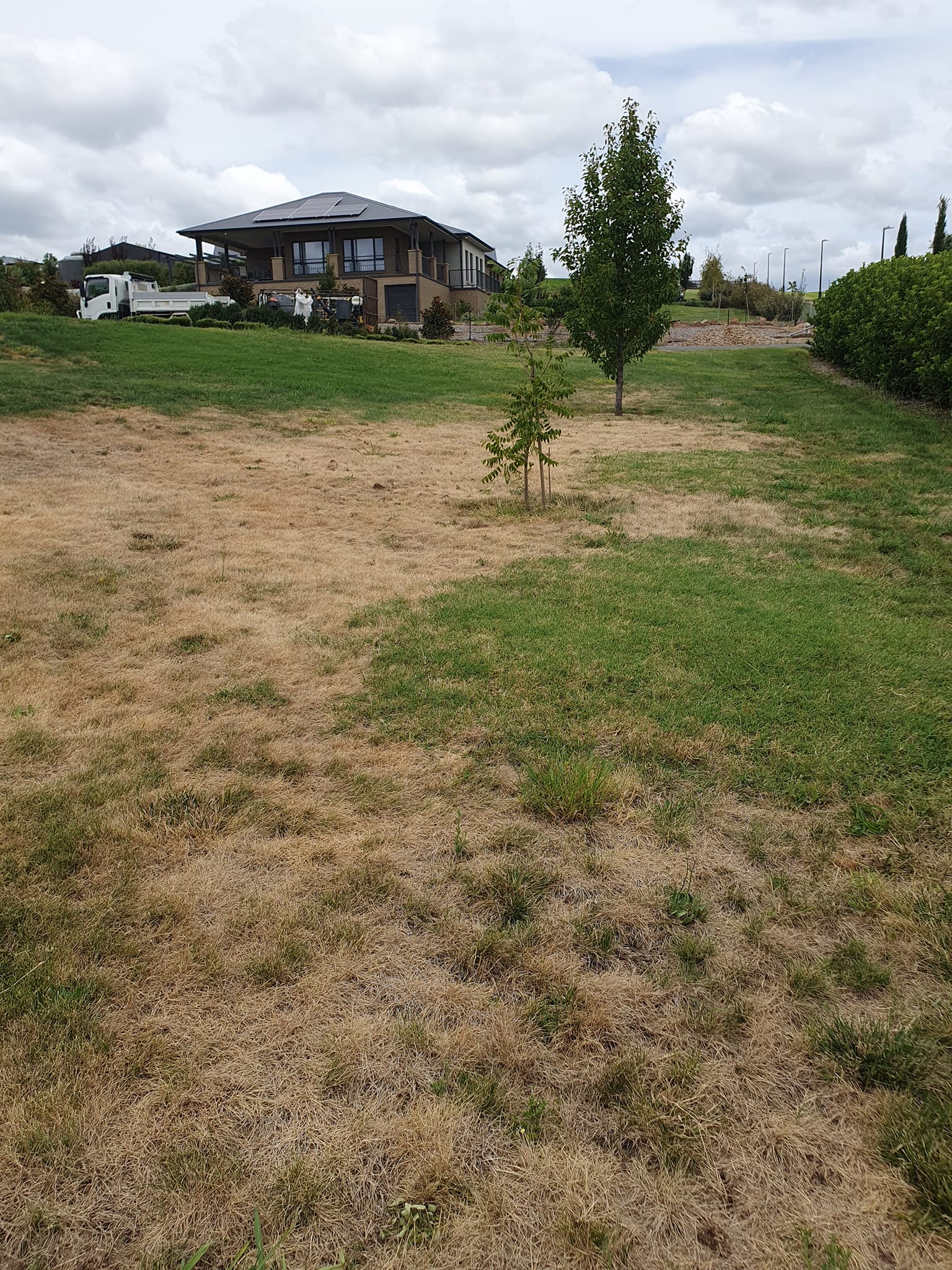What are Turf Grubs and why do we care?
- Turf grubs are the larvae of beetles like Japanese beetles, June bugs, and European chafer beetles
- They are very bad for lawns because they eat grass roots, causing patches of dead grass and weakening the lawn
- This damage reduces the lawn’s health, making it more vulnerable to other pests, heat, drought and diseases
Recent Updates
- The grub population is typically held in some control by winter freezing of the ground. In the Twin Cities the frost usually exceeds three feet
- The winter of ’22-’23 had zero frost and the most frost achieved in ’23’-24 was five inches
- The grub population hasn’t been in control naturally for years
- Grubs in Minnesota have now been identified as the larva of SEVEN different beetle species, each with its own distinct timing and schedules….
- This was one or two species just five+ years ago
- See the articles under the images below for more info
Quotes/info from University of Minnesota Field Day 9/27/23:
“Grubs are becoming more and more of an issue… And they will continue to be more and more”
“Better soil and more grass equals more grubs”
“If you have or have had grubs, You’ll probably continue to have grubs”







TWO INVASIVE INSECTS FOUND FOR FIRST TIME IN MINNESOTA
Residents are asked to report any suspected finds
Two invasive insects new to Minnesota were reported to the Minnesota Department of Agriculture’s (MDA) Report a Pest service in August. Both insects were reported by two separate vigilant homeowners and were later confirmed as invasive insects: The elm seed bug (Arocatus melanocephalus) and Asiatic garden beetle (Maladera formosae).
Elm Seed Bug
The elm seed bug is an invasive insect that has piercing sucking mouth parts and primarily feeds on elm seeds but can also feed on linden and oak. The elm seed bug is mostly considered a nuisance pest like the box elder bug, as they can enter homes in large numbers. Box elder bugs are active in late summer and fall, but the elm seed bug is active in mid-June.
Native to Europe, elm seed bug was first confirmed in the United Stated in 2012. It is established in several western states, such as Oregon, Washington, and Utah.
Adult elm seed bugs are about 1/3 inch long; they’re a dark rusty-red and black color. The underside of the insect is red. On the back behind the head, there is an upside-down black triangle set inside two rusty-red triangles. Next to the edges of the wings where the abdomen is exposed are alternating white and rusty red-black patches.
Best management practices include sealing cracks and crevices on the exterior of buildings so the insects cannot enter and vacuuming up insects that make it inside. To limit entry into structures, there are certain insecticides that can be applied as a barrier treatment.
Asiatic Garden Beetle
The Asiatic garden beetle is an invasive insect that feeds on over 100 hosts, including fruit, vegetables, perennials, and annuals. Grubs prefer roots of ornamentals and garden plants. Preferred hosts include butterfly bush, rose, dahlia, aster, and chrysanthemum. Adults feed on the leaves and flowers of their host plants. Heavy infestations can lead to complete defoliation except for the leaf midribs.
Native to Japan and China, this beetle was first found in the United States in New Jersey in 1922. It is established in New England and a few Midwestern states, including Illinois and Indiana.
Asiatic garden beetles are about 3/8 inch long, are chestnut brown, and may have a slight iridescent sheen. The abdomen protrudes slightly from the wing covers. Adults emerge at night and fly actively when temperatures are above 70 degrees Fahrenheit. They are related to Japanese beetles but differ in that Japanese beetles fly and feed during the day and Asiatic garden beetles feed at night.
Since both elm seed bug and Asiatic garden beetle are newly discovered in Minnesota, the MDA would like to better understand where these insects may be in the state. Residents can report suspected sightings of both insects to the MDA’s Report a Pest line or call 1-888-545-6684. Please include clear photos when submitting a report online.
More information is available on elm seed bug and Asiatic garden beetle.
###
Media Contact
Brittany Raveill, MDA Communications
651-201-6131
Brittany.Raveill@state.mn.us

Another invasive insect confirmed in Minnesota
August 10, 2020
The Minnesota Department of Agriculture (MDA) has confirmed that European chafer (Amphimallon majale) has been found for the first time in the state. This invasive insect is a severe pest of turfgrass. First found in the U.S. in New York in 1940, European chafer is now found in 10 states including parts of Wisconsin and Michigan. The first European chafers in Minnesota were found in south Minneapolis earlier this summer.
European chafer is about ½ inch long and is tannish to reddish brown.
It resembles a May/June beetle, although May/June beetles are usually a little larger and darker in color.
Adult European chafers typically emerge from the soil in early summer at dusk on warm, clear nights.
They swarm around small trees and shrubs to mate for several hours before returning to the ground. It is easy to miss their activity.
While the adults are not pests, the larvae (grubs) are considered more destructive to turf than Japanese beetles because they feed longer during the year.
- The grubs have a reddish yellow head with conspicuous legs and a body bent into a C-shape.
- They range in size from ¼ inch to almost one inch.
- They look very similar to Japanese beetle and May/June beetle white grubs and can only be distinguished by close examination of the tip of their abdomen.
The MDA wants to better understand where European chafers are in Minnesota. Minnesotans can report suspected European chafers to the MDA’s Arrest the Pest line at arrest.the.pest@state.mn.usor 1-888-545-6684.
Before making a report, capture the insect, take a picture, and put the insect in a container or plastic bag and save it in the freezer. The MDA will contact you if they need the specimen for confirmation.
For more information, see MDA’s European chafer page.
Jeffrey Hahn, Extension entomologist

EUROPEAN CHAFER
Scientific name: Amphimallon majale Razoumowsky (Syn. Rhizotrogus majalis)
Native range: Europe
At Risk
The European chafer is a very serious grub pest of turf and can cause more turf damage than the Japanese beetle. Part of this difference may occur because the European chafer spends a longer portion of the summer feeding on turf. However, adult European chafers do not eat at all and so are not the problem defoliators that Japanese beetles are. Home lawns, golf courses, and turf growers have the potential to be most significantly impacted if the European chafer beetle were to become established in Minnesota.

Distribution
European chafer beetle was discovered in the U.S. in 1940, in a nursery near Rochester, New York. It has been reported in New York, New Jersey, Connecticut, Pennsylvania, Massachusetts, Rhode Island, Ohio, Michigan, Delaware and southern Ontario. In Michigan, the European chafer is now common through most of the Lower Peninsula. European chafer was reported for the first time in Wisconsin in Door County during July 2013. Minnesota had its first detection of the European chafer beetle in south Minneapolis located in Hennepin County in 2020.
Biology
Adult beetles emerge from the soil between mid June and early July in Michigan and New York, though emergence times vary and depend on temperature. Most European chafer beetles have one generation per year, but a small proportion of the population may require two years to complete development. Adults are active on warm evenings (above 65 degrees F) for several hours just before and after sunset. Eggs are laid two to four inches below the soil surface and hatch in early August. Larvae feed on the roots of turf. Grubs overwinter just below frozen soil and return to the surface as soon as the ground thaws. When the grubs are ready to pupate in late spring to early summer, the grubs will again descend lower in the soil.
Identification
European chafer adults are about a half-inch long and tannish in color. They are similar to the “June bugs” commonly found in Minnesota in early summer but are generally a bit smaller and lighter in color.
Larvae have the typical C-shaped appearance of white grubs and can range from ¼-inch to 1-inch long with a dark brown head and conspicuous legs. The grubs may be distinguished from other white grubs through characteristics of the posterior of the abdomen, but an experienced entomologist may be needed.

European chafer in comparison to other turf beetles. Image courtesy of The Ohio State University.

Regulatory Status: Non-Regulated
What Can I Do?
Visit the University of Minnesota website for information about diagnosing and managing problems with lawns and turf. Contact the MDA via Arrest the Pest if you suspect an infestation of European chafer in Minnesota.





